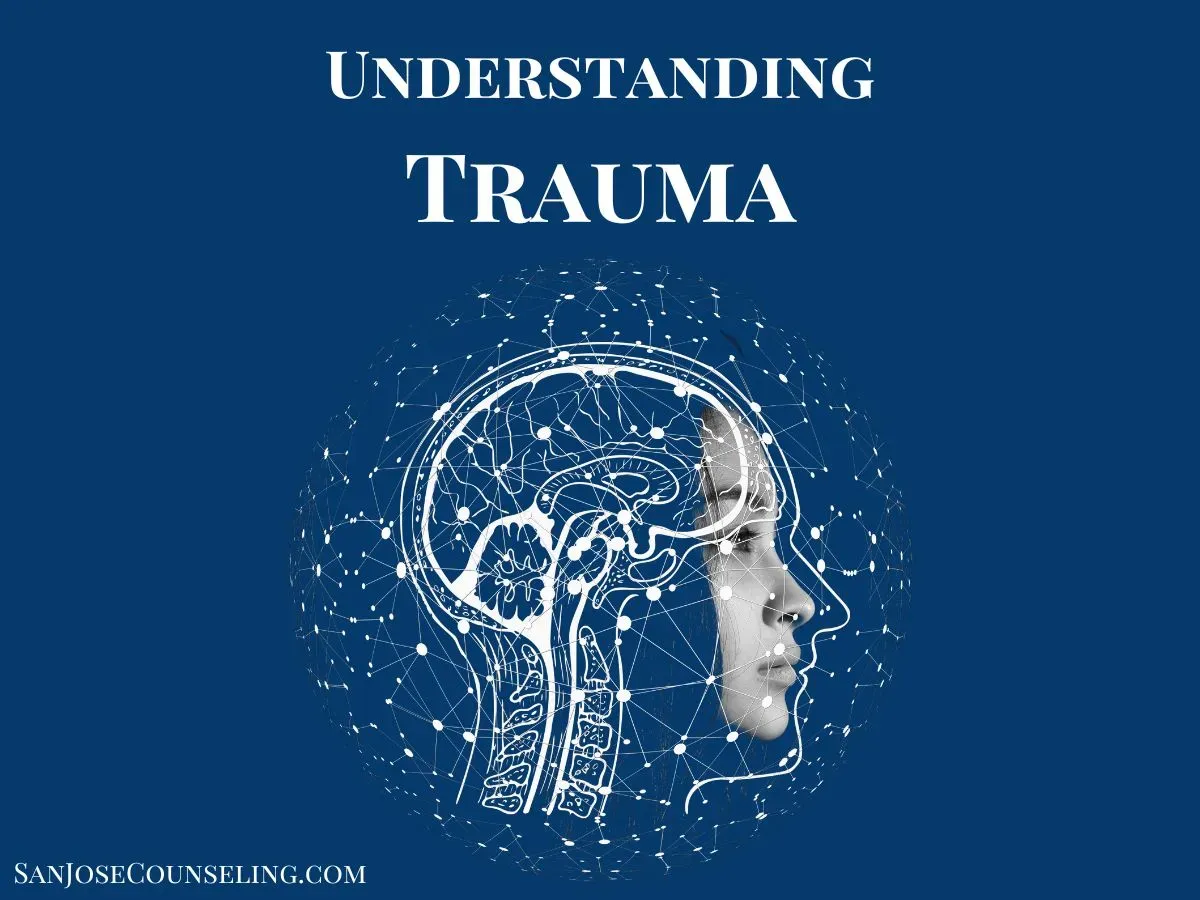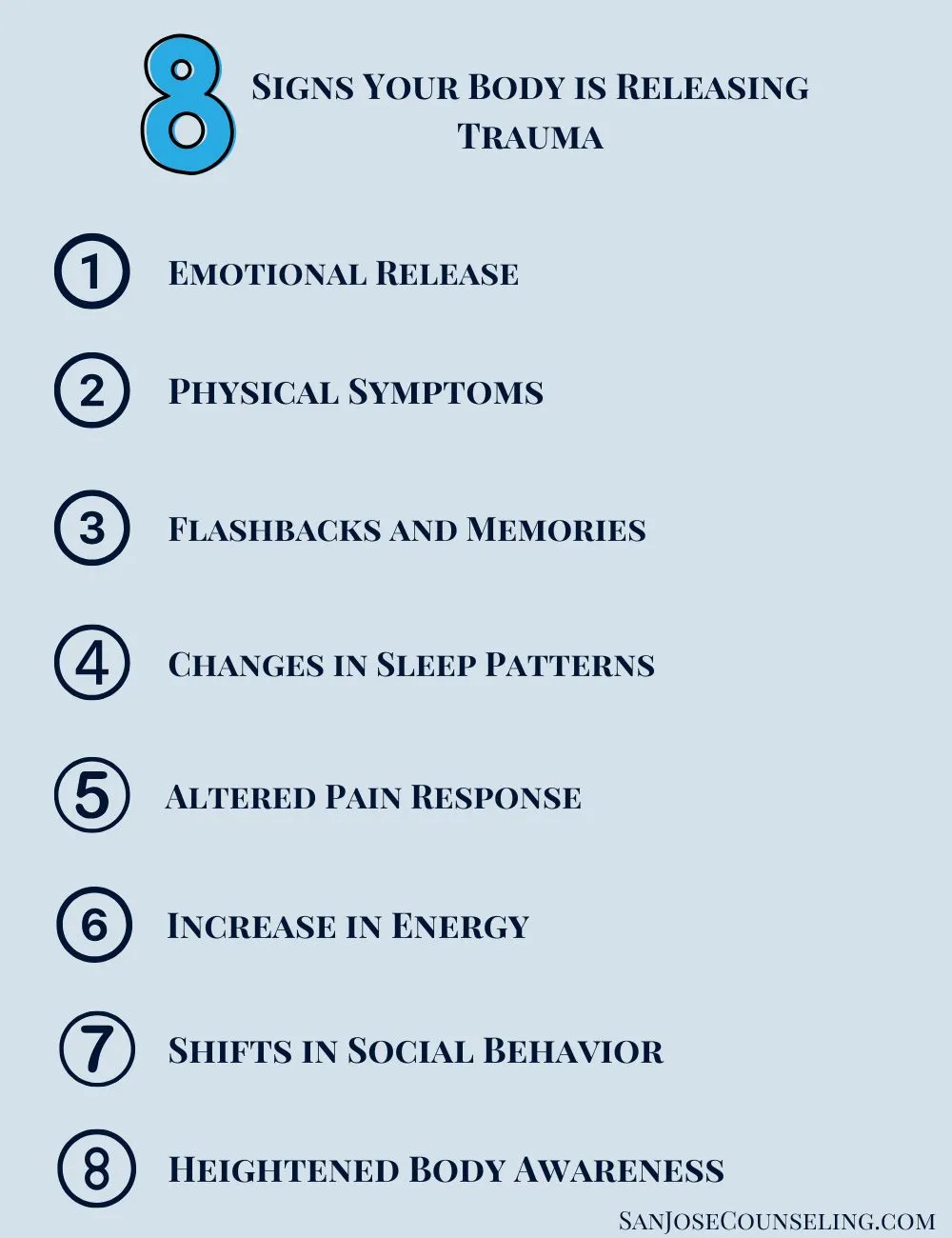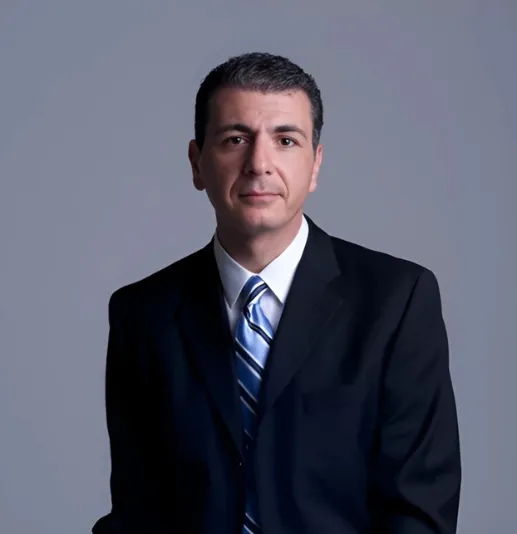Seek Therapy
408-920-1730
Signs Your Body Is Releasing Trauma
Trauma enters our brain and body creating deep and serious changes within us. When experiences surpass our coping abilities, they become trauma and create persistent damage to our mind and body.
Your path to recovery starts when you spot how trauma shows up in your body because you need to understand both its origin and its effects.
You can visit SanJoseCounseling to learn about our therapy approaches. To start your recovery journey, you need to follow these essential steps to regain control of your mind and body.
Understanding Trauma

When someone experiences a severe disturbing event, they develop trauma that disrupts their daily life and produces lasting helplessness.
This mental health problem shows itself through several physical and psychological signs and can progress into PTSD.
People develop trauma through many traumatic events, such as personal violence, natural catastrophes or major crashes, which harm their lives in total and permanent ways.
Trauma continues to affect people's overall health over the long term while also changing how they act and connect with others.
Recognition of trauma allows people to find the physical and emotional signs showing their body works through and eliminates trauma. For more information, visit our website.
Signs of Trauma
After a traumatic event, people will show different reactions, but common issues include emotional shifts, repeated bad dreams and moments when past events replay in their minds, leading to extreme nervousness.
Physical problems, including sleep issues, tiredness, and unexplained body pains, require treatment to stop them from lasting.
Recognizing traumatic symptoms helps people get treatment sooner and learn which treatment methods will help them recover better.
Trauma and Body: Is Trauma stored in the body?
Research shows trauma affects both the mind and body because traumatic memories live physically within us.
The physical evidence of trauma consists of ongoing pain and muscle tightness as well as specific medical symptoms that reflect unresolved traumatic experiences.
The physical responses of your body serve as vital signals that require your attention and care. Our physical responses and overall health depend greatly on body memory, which retains past traumas that our conscious mind has forgotten.
Concept of Body Memory
Our body stores traumatic experiences beyond our brain in the actual tissues that make up our physique. These reactions create physical symptoms called somatic memories, which happen because past trauma resurfaces as physical responses when triggered by specific events.
Just as the mind keeps memories alive, so does the body, which has its own method of remembrance. The body develops instant physical symptoms when it encounters situations that activate traumatic memories.
8 Signs Your Body is Releasing Trauma
Your body shows different signs when it starts to release trauma as both your physical and mental systems work through earlier distressing events.
Detecting these indicators shows essential progress in your path to getting better and moving forward. Here are eight signs that suggest your body is releasing trauma:

1. Emotional Release
People can suddenly have strong emotional reactions they can't control. Your body may release trauma through unexpected bursts of emotional reactions such as tears, laughter, loud sounds, deep sadness, or anger.
Your body releases stored emotional energy when it frees itself from lingering trauma-based stress.
2. Physical Symptoms
Your body starts shaking and trembling while releasing trauma and potentially making chronic pain feel worse for a short period.
These symptoms show how the body lets go of the stress it stored inside its tissues.
3. Flashbacks and Memories
When trauma comes out of the system, it brings back strong sensations and past traumatic memories to life.
The body naturally uses memory recovery to find meaning in what previously happened, even if this process brings discomfort.
4. Changes in Sleep Patterns
As trauma begins to release, your sleep may improve or become marked by vivid dreams and nightmares. The brain appears to process traumatic experiences when the person relaxes.
5. Altered Pain Response
The healing process may alter how your body feels physical pain. After trauma release, people react differently to physical discomfort, with some reporting reduced chronic pain while others becoming more sensitive to pain.
6. Increase in Energy
Rebuilding love isn't just about repairing damage, but deeply understanding your relationship's basic values.
Looking back on what you've learned together and how you've both grown can help you appreciate the strength of your connection and the resilience you've developed together.
7. Shifts in Social Behavior
People often change their social habits after trauma by wanting stronger friendships or needing additional private space.
As people work through their trauma, their social habits adjust to show how safe they feel and whom they now trust.
8. Heightened Body Awareness
Recognizing your body's heightened responses to physical sensations and understanding its needs are signs of trauma healing.
When people become more aware of their physical sensations, they improve their mental-body connection, which helps with recovery.
Related: When to Walk Away from Someone with Mental Illness – 50 Signs
1. How long does it take to release trauma?
How quickly trauma goes away differs from person to person. Different elements, including trauma characteristics, together with mental health level and therapy methods, decide the speed at which people recover from their experiences.
While some people feel better after months of effort, others require many years of professional and self-support to heal.
2. What if your body fails to release (stored) trauma?
Unprocessed trauma builds up in your body and creates lasting problems for both mental and physical health, including anxiety disorders, depression, PTSD and physical pain symptoms.
Unprocessed trauma blocks a person from living well because it disrupts their ability to maintain relationships and perform at work while harming their physical health.
These situations need immediate professional assistance. EMDR treatment, along with cognitive-behavioral therapy and other trauma therapies, work effectively to help people release accumulated trauma responses.
Strategies To Support Yourself When Your Body is Releasing Trauma
When trauma release starts in your body, you need to use specific steps to help your recovery and handle the symptoms as they show up. Here are three effective strategies to consider:
1. Seek Professional Help from a Trauma Therapist
Working with trauma specialists helps you make better progress toward healing. Trauma therapists apply tested treatment methods to help you face and overcome trauma in a secure way. The healing approaches EMDR, TF-CBT, and somatic experiencing let the body and mind work together to recover from trauma.
You can speak about your trauma feelings in a protected space while experts help you understand your emotional responses and navigate through your release process.
Find available therapy choices through Therapy – Dr. Invia A. Betjoseph.
Talk to Dr. Invia — licensed Marriage & Family Therapist.

2. Practice Self-Care
Taking care of yourself helps your body recover from harm naturally. Physical health activities like regular workouts plus diet and sleep help your body find balance and feel better.
To maintain emotional well-being, consider practicing meditation, yoga or connecting with nature. When you engage in these activities, your mind and body can transition towards recovery from trauma because they limit stress reactions and restore emotional balance.
3. Develop Healthy Coping Skills
Making healthy coping strategies part of your life helps you deal better with emotions that come during trauma release.
Your body will respond better to trauma release when you use deep breathing exercises combined with muscle relaxation and mindfulness meditation.
When you use writing, painting or music to express yourself you feel better and gain emotional relief. Getting strong support from therapy groups or personal relationships gives you essential encouragement and helps you heal better from trauma.
These approaches give your mental and physical selves the help they need to release trauma through its healing stages. Everyone finds different methods to cope with trauma, so choose what works best for you to experience recovery while attaining inner harmony. For immediate advice or support, consider our Free Video Consult.
Move Forward and Live a Happy, Healthy and Trauma-Free Life
You brave yourself into better days when you begin healing from past trauma. You will heal better when you combine professional help with methods to grow personally.
Through his trauma therapy techniques, Dr Invia guides PTSD and EMDR patients to heal from trauma while building inner strength and flexibility.
Using these therapy services will help you develop a better, healthier life without trauma effects.
FAQS
- What does trauma release in the body feel like?
Your body lets go of trauma through emotional outbursts that cause you to cry and shake. The body feels substantial relief when stress leaves your system.
- What are the physical signs of unhealed trauma?
Physical health suffers from unhealed trauma because it results in lasting tiredness plus repetitive headaches. The symptoms frequently show up with lasting feelings of nervousness and constant worry.
- What are the physical signs of processing trauma?
Your body shows trauma processing through physical reactions such as heartbeat changes along with sweating and shivering when you emotionally recover.
These bodily reactions show that your system is taking action to fix trauma-related problems and enhance healing.


